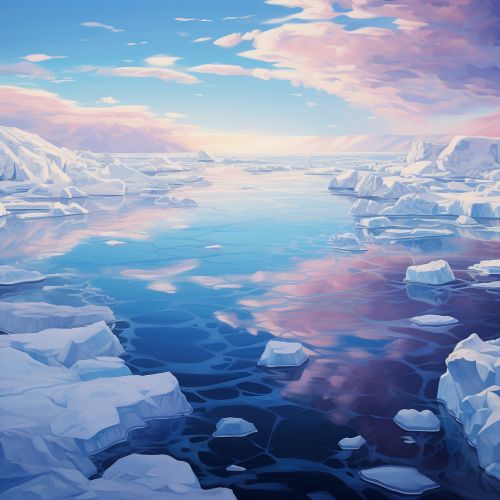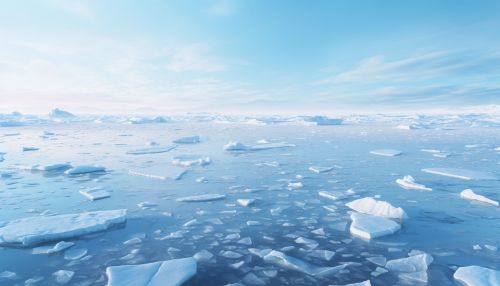Ice floe
Definition and Formation
An Ice floe is a large pack of floating ice often seen in large bodies of water, such as oceans and seas. It is formed when the surface of the water freezes due to extremely low temperatures, usually in polar regions. The formation of ice floes is a complex process that involves the interaction of water, air, and temperature.
The process begins when the air temperature drops below the freezing point of water. This causes the surface of the water to cool and eventually freeze, forming a thin layer of ice. As the temperature continues to drop, the ice layer thickens and expands, eventually forming an ice floe. The size and shape of the floe can vary greatly, depending on factors such as the temperature, wind, and water currents.


Characteristics
Ice floes are characterized by their large size and flat surface. They can range in size from a few meters to several kilometers in diameter. The surface of the floe is usually smooth and flat, but can also be rough and jagged, depending on the conditions under which it was formed.
The thickness of the ice can also vary greatly, from a few centimeters to several meters. The thickness is determined by factors such as the temperature, the duration of freezing, and the amount of snowfall. In general, the colder the temperature and the longer the freezing period, the thicker the ice will be.
Ice floes are not stationary, but move with the water currents and winds. This movement can cause the floes to collide and form ridges or cracks. These features can make navigation through ice floes challenging and potentially dangerous.
Ecology
Ice floes play a crucial role in the Arctic ecosystem. They provide a habitat for a variety of organisms, from microscopic phytoplankton to large mammals such as seals and polar bears. These organisms rely on the ice for survival, using it as a platform for resting, breeding, and hunting.
Phytoplankton, the primary producers in the Arctic ecosystem, thrive in the nutrient-rich waters beneath the ice. They form the base of the food chain, providing food for a variety of organisms. Zooplankton, small crustaceans, and fish feed on the phytoplankton, and in turn are preyed upon by larger predators.
Seals and polar bears are among the most iconic species associated with ice floes. Seals use the ice as a platform for resting and giving birth, while polar bears rely on the ice for hunting seals. The decline in ice floe coverage due to climate change is a major concern for these species, as it reduces their habitat and makes hunting more difficult.
Impact of Climate Change
Climate change is having a significant impact on ice floes. Rising global temperatures are causing the ice to melt at an unprecedented rate, leading to a reduction in the extent and thickness of ice floes. This has serious implications for the organisms that rely on the ice for survival, as well as for human activities such as shipping and oil exploration.
The loss of ice floes is also contributing to a positive feedback loop of global warming. Ice is highly reflective, bouncing back most of the sun's rays and helping to keep the planet cool. When ice melts, it exposes the darker water beneath, which absorbs more of the sun's heat, leading to further warming and more ice melt.
Scientists are closely monitoring the changes in ice floe coverage and thickness as a key indicator of climate change. The data collected is used to improve climate models and predict future changes in the Arctic ecosystem.
